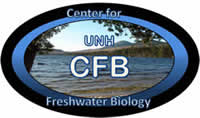Abstract
As part of a comparative assessment of seven New Hampshire lakes, performed throughout the month of September 2003, students and faculty from the University of New Hampshire’s Center for Freshwater Biology sampled Christine Lake in Stark, NH. The goal of the study was to quantify the lake’s physical, chemical, and biological properties and compare it to the six other lakes studied, as well as to results from identical sampling of Christine Lake in June, 2003.
Christine Lake is an oligotrophic lake with very little primary production and low densities of zooplankton. Nutrient levels were low, likely due to the forested composition of the lake’s watershed and the small number of homes on the lake’s shore. The low phosphorus concentration and high N:P ratio (TN:TP = 50) typify a phosphoruslimited system which is likely to be the cause of the minimal algal abundance (1.6 ± 0.1 µg L-1 average epilimnetic chlorophyll compared to 39.4 ± 1.0 µg L-1 in eutrophic York Pond). Predation by young Brook and Brown Trout most likely favored the increased densities of the smaller zooplankter Bosmina (average body length: 0.42 mm ± 0.01), as they are not readily visible to the trout like the larger Daphnia (average body length: 1.39 mm ± 0.03). Evidence for increased predation on Daphnia can be seen in their location in the water column (8 m and 12 m) which indicates migration to deeper waters to avoid fish predation. The depressed density and size of the zooplankton in the lake are most likely due to a lack of suitable grazing material and predation from the planktivorous fish population. Interactions between zooplankton and higher trophic levels, as well as phytoplankton, are discussed in the context of a model food web.
Publication Date
1-1-2004
Publisher
UNH Center for Freshwater Biology Research
Document Type
Article
Recommended Citation
Godkin, W. Travis, "An assessment of the physical, chemical, and biological properties
of Christine Lake, NH" (2004). Center for Freshwater Biology. 11.
https://scholars.unh.edu/cfb/11

